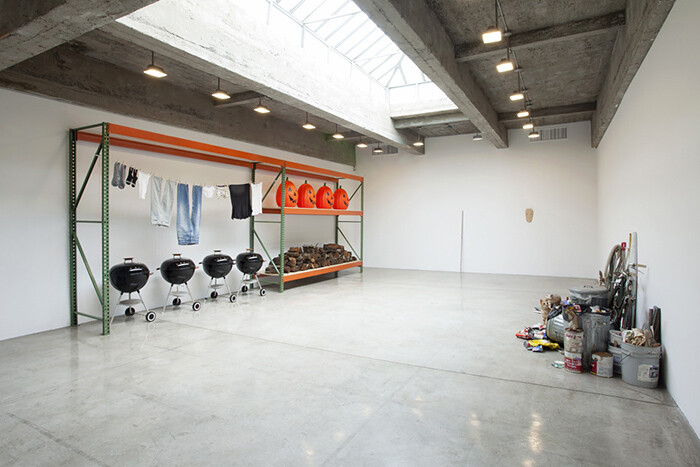The 1990s art world began with the rumblings of multiculturalism and identity politics and closed with a resurgent art market interested in—as it frequently is—painting, and figurative painting in particular: John Currin, Lisa Yuskavage, and the total ascendance of Gerhard Richter. In between these two moments a variety of forms proliferated, especially installation and new media works, and so it’s not a surprise that there isn’t much painting on display at Tanya Bonakdar Gallery’s own survey of the decade: “The Bigger Picture: Work from the 1990s.” In fact, the exhibition is as much a celebration of the gallery’s first twenty years as it is any kind of time capsule or historical summary of the period.
Although founded in New York’s SoHo in 1994, Tanya Bonakdar Gallery made the early move to Chelsea in 1998. International notables such as Phil Collins, Olafur Eliasson, Ernesto Neto, Sarah Sze, and Gillian Wearing all have work in “The Bigger Picture” as part of a mid-1990s openness that gradually evolved—paralleling the rise of social media—into a late 2000s state of anything goes. But the historical still registers, if mostly in terms of the trajectory individual artists took, as in Eliasson’s early experiments with perspective and perception in Convex/concave (1995/2000), a kinetic work which utilizes a mechanical air pump to make a round mirror’s reflection pulse forward and back. Similarly, his foil-lined, hexagonal cone, Your Compound Eye (1996), turns vision prismatic by fragmenting the view through it. These are the modest beginnings of the kinds of monumental, phenomenologically based installations Eliasson would later produce, such as Take Your Time (2008), a forty-feet-in-diameter, slowly rotating mirror attached to the ceiling.
Other works in “The Bigger Picture” look toward the past or anticipate future trends. Although Haim Steinbach has been placing relatively inexpensive, shiny, store-bought items on painted, prefabricated shelves since the 1980s, he adds a twist in Backyard Story (1997), one of the larger pieces he’s ever produced. With oversize plastic jack-o’-lanterns on a shelf above a low stack of firewood, the installation also includes a clean, yet slightly distressed set of clothes for men and boys, which hangs on a clothesline above four black Weber-brand grills, themselves just less than pristine. The suburban backyard-as-boutique looks a little rough around the edges, though not nearly as much as Mark Dion’s urban diorama, Concrete Jungle (Mammalia) (1993), on the opposite wall. Part of a larger series, it depicts overflowing and tipped trash cans, an old bicycle, plastic crates filled with junk, and a stuffed squirrel, possum, cat, and raccoon. This is the “peaceable kingdom” as located in recession-era New York.
“The Bigger Picture” includes a variety of echoes, like Sze’s installation Untitled (Thessaloniki) (1997), which plays off of Dion’s display. A highlight of almost any exhibition, Sze’s work appears on both sides of the gallery’s front window. Made from the common and everyday materials for which she is known, the piece is a precise arrangement of cans of pinto beans and Pringles, packing tape, aluminum bread pans, small boxes of raisins, disposable razors, and bite-size candies on the gallery floor; on the sidewalk outside, rows of plastic clothespins and forks, unsharpened pencils, packets of gum and soy sauce, Q-tips, and a FedEx envelope are carefully arrayed (an assistant from Sze’s gallery re-installs the outdoor component each morning). Whimsical yet formally exacting, Untitled (Thessaloniki) is commodity culture’s equivalent to a 1960s Bruce Nauman working in his studio with next to nothing, but nevertheless managing to create something entirely fresh and new.
Among the most forward-looking works in the exhibition engage with portraiture: three photographs and an accompanying video by Wearing. For the first of these, she took pictures of people carrying small signs best described by their shared title, Signs that say what you want them to say and not Signs that say what someone else wants you to say (all works 1992–93). A man with a face tattoo holds a sign stating, “I have been certified as mildly insane.” A woman of African descent believes in reincarnation. Another man declares that, “Everything is connected in life.” Nearby, the video Confess All On Video. Don’t Worry, You Will Be In Disguise. Intrigued? Call Gillian… (1994) features individuals wearing a mask and wig, who each tell a unique story, such as having the compulsion to make obscene phone calls. Wearing’s work anticipates the parade of selves social media has come to elicit, and more recently demanded, with confession or direct experience filtered simultaneously through its partially obscured performance. But as the explosion of fictional documentaries of the post-1990s has taught us, histories of all sorts function this way, too.











